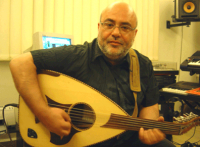Accueil > Modal music resource center > A new magazine devoted to music from the (...)
NEMO

The ICONEA and CERMAA research centers launch the journal NEMO, Near-Eastern Musicology Online. Amine Beyhom, who collaborates with Drom on many levels, is one of the founders.
NEMO is dedicated to research on ancient and current music from the Near and Middle East, as well as other music that can enrich this research. The means of study of this interdisciplinary field range from archaeomusicology to analytical musicology, including historical, systematic, cognitive, ethnomusicological or anthropological approaches.
NEMO will devote particular attention to modality, as a possible link between the music of an area that extends at least from Western Europe to the Arabian Peninsula, and from Iran to Central Africa.
NEMO integrates and replaces the old journal ARANE. It is co-edited by Richard Dumbrill (ICONEA) and Amine Beyhom (CERMAA) and administered by ICONEA. Amine Beyhom is Editor-in-Chief, assisted by Rosy Azar Beyhom.
NEMO wants to be the vector of an active musicology of music from the Near and Middle East and elsewhere, without concessions on the quality and relevance of the articles published, with a permanent concern for the promotion of this music through a better understanding. their structures and their spread or extinction. NEMO’s editorial board, made up of internationally renowned musicologists, is committed to publishing the best articles submitted to the journal.
Editorial committee (in alphabetical order) :
Amine Beyhom (CERMAA – FOREDOFICO ; Lebanon) ;
Philippe Brunet (University of Rouen ; France) ;
Jérôme Cler (PLM – University of the Sorbonne-Paris IV ; France) ;
Richard Dumbrill (ICONEA, Institute of Musical Research, School of Advanced Study, University of London ; Great Britain) ;
Jean During (CNRS ; France) ;
Bruno de Florence (ICONEA, Institute of Musical Research, School of Advanced Study, University of London ; Great Britain) ;
Paul Mattar (CERMAA Center – FOREDOFICO / IESAV – St-Joseph University ; Lebanon) ;
Nicolas Meeùs (PLM group – University of the Sorbonne-Paris IV ; France) ;
Mourad Sakli (ISM of Tunis / CMAM ; Tunisia)
Writing and submission standards :
Authors are solely responsible for the content of their articles. Articles should be sent in German, English, Arabic or French to Amine Beyhom ; they must be submitted in “.doc” or “.rtf” format and be accompanied by a verification “.pdf”. Notes should be numbered continuously and included at the bottom of the page. Illustrations, in black and white or in color, must be provided in at least 300 dpi in “.jpg” or “.tif” formats, and numbered with cross-references in the text (“see Fig. X, Tabl. Y”) . The illustrations, photos, sheet music etc. subject to copyright must be accompanied by the written authorization of the rights holders. The article must not exceed in volume about thirty pages of 1800 characters each, the standard being between 15 and 20 pages ; however, in-depth articles justifying voluminous treatment may, on an exceptional basis, be taken into account for publication. Quotations must be clearly identifiable, by putting them in quotation marks or by detaching them from the body of the text and indenting the quotation ; quotes in foreign languages should be italicized ; translations of texts must be accompanied, in notes, by the translated original placed between quotation marks. Finally, the name of the author will be accompanied by a note indicating his titles and qualities, and the article must be accompanied by an abstract in English of 10 to 20 lines at most, with the exception of articles in Arabic. which will be accompanied by a summary of 30 to 40 lines.
The bibliographical references must be grouped together at the end of the article, and include sufficient indications for an identification of the cited reference (we recommend the use of the conventions of the Bibliography of the Modality). Transliterations must imperatively follow the journal’s standards : transliteration tables and other additional information will soon be available on the journal’s website (www.nemo-online.org). The Arabic transliteration can be downloaded here.
Edit protocol :
The article is first reviewed for consistency and compliance with submission standards by the editorial board, then sent to two double-blind reviewers for corrections and possible requests for changes. In the event of acceptance of the article and agreement of the author and the evaluators, the author will be able to re-read, after corrections approved by the editorial board, the first proofs of his article which he will return corrected or will approve in as soon as possible.
Theme of the first issue of the journal :
The theme of the first issue of the journal is “ The modality in question” ; off-topic articles, as well as forums, may be considered for publication in this issue or in one of the following issues. A discussion of the different issues that can be addressed as well as additional information are available on the NEMO website, as well as a basic bibliography of the modality, prepared by the editorial board and intended to be enriched by the contribution of readers.
Articles must be sent, for this first issue, before the end of November 2011.
(CERMAA collaborates, within FOREDOFICO, the Lebanese foundation for music and the arts, with CETEP, the Center for Translation, Editing and Publication of the foundation)